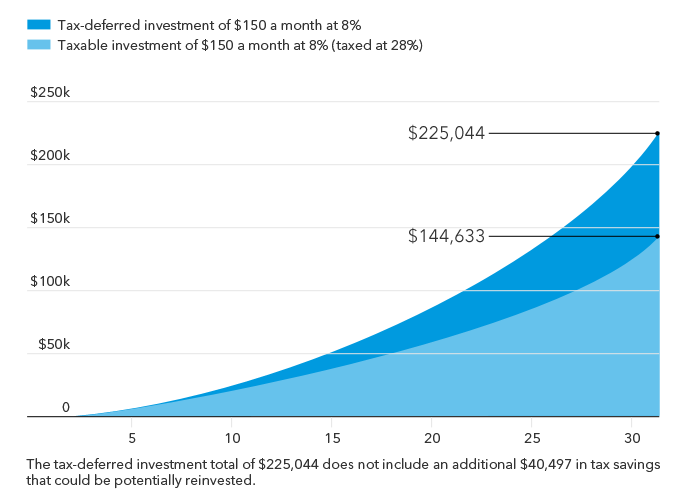401(k)s and other salary deferral plans
-
-
Why participate?
A salary deferral plan lets you shape your own retirement savings program so you can think beyond Social Security benefits. Below are three reasons to participate.
Everybody loves a tax break
Your employer’s 401(k) plan probably uses one or both of the following contribution methods. Each offers a tax benefit:
- Traditional contributions: You’re getting a tax break up front with traditional contributions because the money going into your account has not been taxed. By postponing taxes until you take withdrawals, you have more money working for you.
- Roth contributions: Money going into a Roth account is taxed before you invest it, but qualified withdrawals, including any earnings, won’t be taxed.*
Check with your employer to find out which contribution types your plan offers.The chart below shows the hypothetical growth over 30 years of a traditional, tax-deferred investment compared with a taxable account.
- Traditional contributions: You’re getting a tax break up front with traditional contributions because the money going into your account has not been taxed. By postponing taxes until you take withdrawals, you have more money working for you.

This illustration compares investing before taxes are paid with investing the same amount after taxes are paid. Taxes are paid annually out of the taxable account. If a lump-sum withdrawal was taken at the end of the investment period, the full accumulation value of the tax-deferred savings would be subject to taxation as current income. This may or may not be to your advantage. Talk to your financial professional or tax advisor about withdrawal options. The value of a lump-sum withdrawal at the end of the period, assuming a 28% federal tax rate, would have been approximately $162,032. Exemptions and other taxes are not reflected. Assumes a hypothetical 8% return rate, compounded monthly, and a 28% federal tax bracket. While no further taxes are due on the taxable amount, any distribution from the tax-deferred account would be fully taxed, and, if applicable, subject to additional penalties for early withdrawal. Regular investing does not ensure a profit or protect against loss. Carefully consider your current and anticipated investment horizon and income tax bracket when making investment decisions, as this illustration may not reflect these factors.
You wouldn’t turn down free money
Many companies offer matching funds as an incentive to encourage employees to contribute to their salary deferral accounts. If your employer offers to match your retirement contribution, take it. It’s as if your employer is paying you a bonus — and all you have to do is save in the plan. Contribute at least enough to get the full match. If the match is in company stock, think about diversifying the rest of your account. The match is part of your benefits package. Don’t walk away from it.
Social Security won’t be enough
If you plan to rely on Social Security to pay all your bills, your retirement dreams may need to be trimmed back. The rule of thumb is that Social Security probably represents only 40% of your retirement needs. In January 2022, the average monthly benefit for a retired worker was $1,660.90†. Even with cost-of-living increases, this won’t buy the kind of retirement most Americans dream about. When you participate in your retirement plan, you take control of supplementing Social Security.

Visit the Social Security Administration website for more information about the retirement benefit you can expect.
-
Plan types
-
Payroll deductions
-
Vesting
-
Rollover options
-